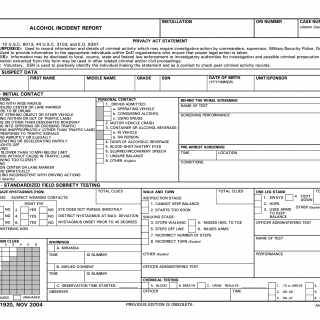DD Form 1920. Alcohol Incident Report
The DD Form 1920 is an Alcohol Incident Report used in the United States military to document and investigate incidents involving alcohol. This form is essential for maintaining proper record keeping and ensuring that appropriate action is taken in response to alcohol-related incidents.
The DD Form 1920 consists of several important fields, including the date and time of the incident, the location, the names and ranks of all involved parties, witnesses, and any injuries sustained as a result of the incident. It also asks for a detailed description of the incident and any actions taken by those involved or responding personnel.
When filling out this form, it is important to provide accurate and complete information. Any supporting documentation, such as medical reports or witness statements, should be included to provide a comprehensive understanding of the incident.
Examples of situations where the DD Form 1920 might be used include incidents involving drunk driving, underage drinking, or disorderly conduct related to alcohol consumption. The form serves as an official record of the incident and can be referred to in legal proceedings.
Strengths of the DD Form 1920 include its ability to provide a clear and concise record of alcohol-related incidents, which can help identify patterns and trends. Weaknesses may include its reliance on accurate reporting and the potential for bias or incomplete information to be included.
There are no direct alternatives to the DD Form 1920, but similar forms may be used for documenting incidents in non-military settings.
Once completed, the DD Form 1920 is typically submitted to the appropriate military authorities for review and storage. It may also be used in future disciplinary or legal proceedings.
In summary, the DD Form 1920 is a crucial document for documenting and investigating alcohol-related incidents in the US military. Its accurate completion and submission can lead to effective resolution and prevention of future incidents.

